Two Parts to a Sweet Treat
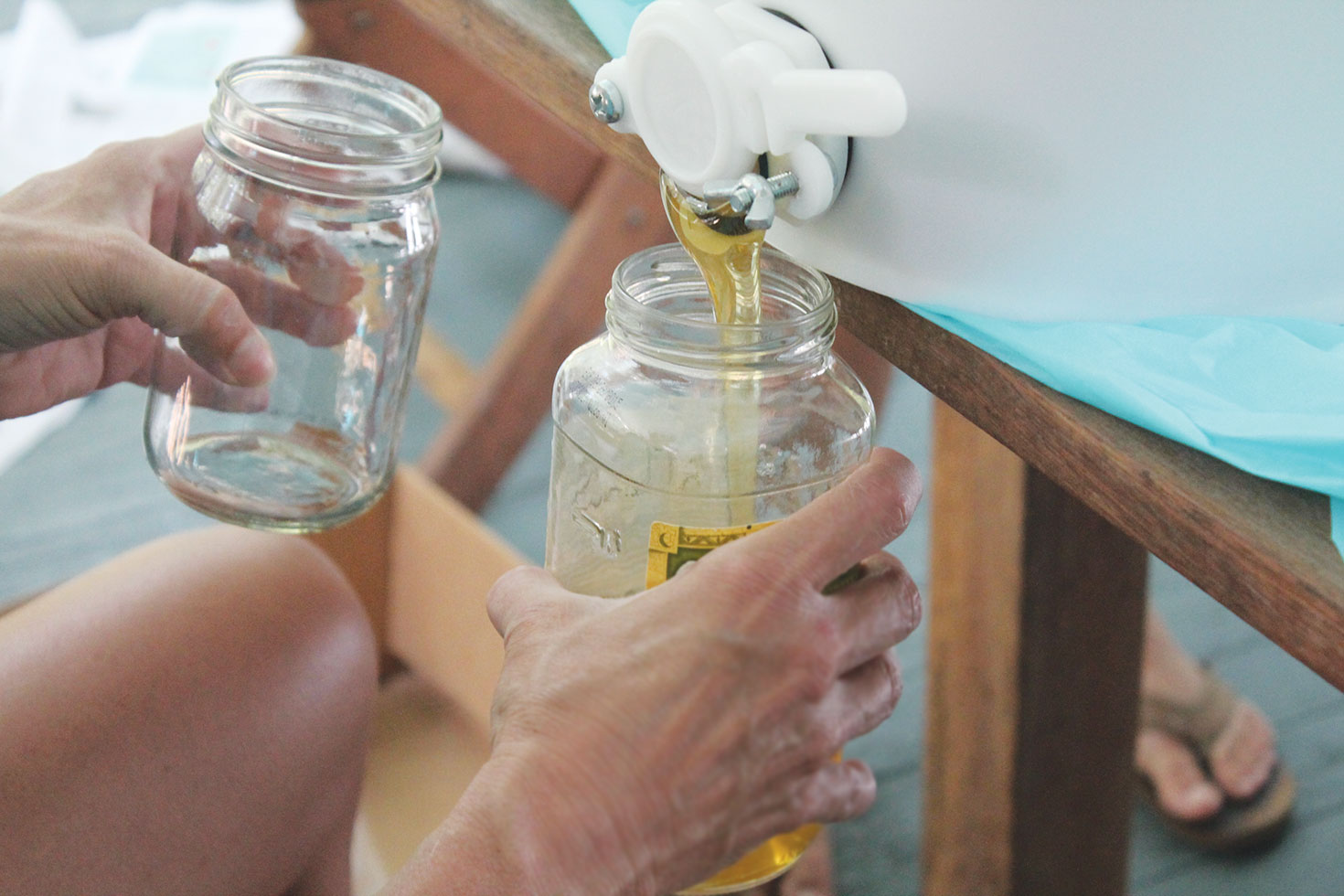
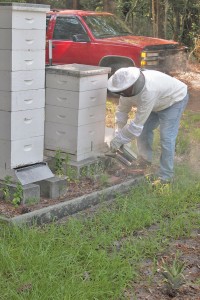
Dr. Keith Reschly smokes the bees with burning pine straw so the stinging insects—North Carolina’s state insect, in fact—will mellow out before harvest. Photo by Kris Beasley
As fall pollen season is upon us, many allergy sufferers wander in search of local honey as a natural allergy treatment to help relieve the symptoms they endure. Although unproven in terms of modern scientific methodology, those who experience symptom relief with use of raw honey are believers in this remedy.
Honey has been used for health and medicinal purposes for centuries. Ancient Egyptians used honey as a wound ointment and embalming fluid. Hippocrates is said to have recommended its use in the treatment of ulcers and sores. Although not documented in current research on humans, honey is believed to have antibacterial, anti-inflammatory and antioxidant properties. It is believed that the darker the color of the honey, the stronger the antibacterial and antioxidant properties.
Overall, honey is felt to be a better source of sweetness than white sugar due to the differing percentages of the carbohydrate components which are easily digestible. Its natural sugar properties provide 64 calories per tablespoon, which is much higher than white sugar at 15 calories per tablespoon. Thus, caution must be used in portion size especially by people with diabetes and those who are overweight, as more calories are provided for each tablespoon. Flavor is dependent on the flower source used by the bees, so it varies by region and even neighborhood.
The search of holistic and naturalistic practices reveals current use of raw honey for many common ailments. Raw honey is not the same as the clover honey you find in many grocery stores. “Raw” honey means it is unpasteurized so it has not been heated to a level to kill organisms often found to be beneficial. The levels of microorganisms remain small due to the fact that there is a low water concentration in honey which prevents their overgrowth. In fact, heating honey to high temperatures has been found to decrease the reported health benefits. However, because of this, raw honey should never be given to a child under the age of 1 year. The immune system of an infant is not developed enough to process the bacteria that an adult can tolerate; raw honey can contain spores of bacteria known to cause botulism which can cause paralysis in an infant.
Honey is suggested by holistic practitioners most frequently for symptom relief in the following conditions:
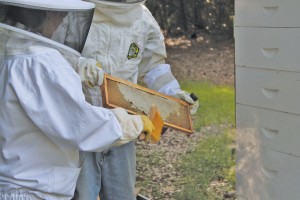
Volunteer beekeepers from the Brunswick County Beekeepers Association remove the wax slats from the hive stands. Photo by Kris Beasley
Cough: Honey coats the throat and temporarily alleviates the symptoms of a dry, irritated throat. Try mixing equal parts of honey, lemon juice and vinegar and using a teaspoon.
Minor burns/sunburn: Relief can be obtained from the pain of minor superficial burns by covering the area with a thin layer of honey. With its professed antibacterial properties, it may even limit infection.
Sore throat: Drop honey in hot water with fresh cut ginger for a soothing relief.
Minor superficial cuts: The honey acts to seal in the wound fluids and prevent drying and infection. Of note, all deep and infected cuts require the attention of medical professionals.
Immunity Booster: Placing one to two tablespoons in warm water with fresh lemon and fresh cinnamon is thought to boost an individual’s immune system and response to prevent infections.
Weight loss/detoxification: One plan suggests combining one tablespoon honey and the juice of one lemon in warm water before breakfast and during the day for “detoxification” effects. Honey is also thought to aid in fat and cholesterol metabolism when combined with cinnamon.
Skin care: Honey is used in skin care products. Drinking milk and honey is thought to promote your complexion. Apply a thin layer of honey to blemishes overnight to improve redness and dryness. In addition, it has been found to relieve the dryness and inflammation of eczema and psoriasis.
Hay fever and allergy symptoms: In theory, local unfiltered honey has small amounts of pollen. Taken regularly, the immune system of the human body develops a tolerance to this pollen which comes from plants in the area so your body is able to tolerate the pollen. The key here is you must start taking 1 tsp every day for up to 6 weeks before the start of allergy season as well as during the peak. Also, the pollen-containing honey must be from plants in your area which cause you irritation, so a local source is best.
As with all medical conditions, seek professional help if you experience prolonged symptoms of cough or sore throat, wounds which do not heal, severe burns, sunburn or infected skin.
Regardless of the remedy effects, honey remains a delicious treat to eat! Enjoy some local honey today!
-Leslie Reschly, BSN, RN
The Land of Milk and Honey
Several years ago while volunteering at a South Brunswick High School swim meet, I met Dr. Keith Reschly. During the course of the four-hour swim meet, I discovered he was a beekeeper. I was so intrigued that I interrogated him about the details of beekeeping until the conclusion of the meet!
He told me about the Brunswick County Beekeepers Association and encouraged me to attend a meeting if I was truly interested. They meet the first Thursday of each month at the Brunswick County Government Center, so I went to a meeting and quickly discovered that there was more to beekeeping than just setting out a white box and honey magically appearing. It was more than I was willing to invest.
Since that time, we have become great friends with the Reschlys, and my husband, Alan, has decided to put the work in and become a beekeeper. Dr. Keith has guided him in buying all the necessary start-up items including: hive stand, hive entrance board, two hive bodies, hive top and cover, wax frames, smoker, bee brush, hive tool, and beekeepers hood and gloves.
The total cost to get started was roughly $395. There are local outlets for buying the products, which you can find out through attending a Brunswick County Beekeepers meeting.
You can start a new hive in the early spring or mid-summer.
I was lucky enough to participate in the harvesting of the Reschlys’ honey this summer. It was a long, hot, sticky process—but what a great experience! A large group of volunteers met at their home early one morning ready to partake in the duties of harvesting honey.
Dr. Keith and his son, Kyle, suited up in full beekeeper suits. We all walked over to his hives and Dr. Keith put some pine needles in his silver smoker can and lit them. He closed the lid and started to disperse the smoke from the can at the bottom of each of the hives. The smoke will mellow the bees to allow him to work on the hive. “You have to wear the hood because the bees will go for your eyes first,” Dr. Keith warned. I took a few more steps back!
Once the hive was thoroughly smoked, Dr. Keith started to pull apart the boxes that make the hive. Each box contains eight wax slats or frames. These are what the bees use to make the honeycomb and the honey. If the slats are waxed over, they are ready for harvest.
Dr. Keith would hand Kyle the waxed-over slats, and Kyle would take them away and blow them down with a leaf blower to make sure no bees were present. Then he would take them to their screened porch to await the next step in the process. It took about an hour or so to remove all the capped slats from his hives.
Next we all gathered in their screened-in porch, where we all raised a small glass of milk and Dr. Keith made a touching toast, “To the land of milk and honey!” We were reminded of God’s great miracles and began the process of removing the honey from the slats.
It was important to stay in the screened porch and not open the door, as the bees would smell the honey and try to reclaim it.
Each slat needed the wax cut off, so that the honey would be released. A large bread knife was used to run across the top of each slat. The cut wax was was put into a large bowl, where we sampled some of the goods. It tasted so delicious.
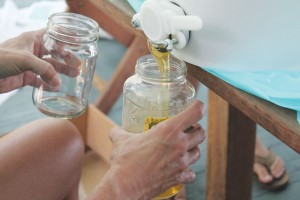
Leslie Reschly and her husband are beekeepers. Here Leslie is filling jars with the most local honey she can find, straight from her bees! Photo by Kris Beasley
It was interesting to see the different hues of the honey. Some slats would be really light in color, while others were dark like mahogany. You could also taste the differences between the two colors.
When the slats were free of wax, they were put into a huge, silver canister called an extractor. Once loaded, Dr. Keith hand cranked the spinner to extract all the honey from the slats. The honey collected at the bottom of the extractor, and once all the slats had been spun, they drained the honey out into a smaller, white bucket with a nozzle valve.
That was then placed on top of the table, and we started to fill the jars full of honey. We must have filled over 100 jars of all different shapes and sizes. “The good thing about this honey is it is not pasteurized, so all the good stuff is still present,” Dr. Keith quipped. And he is right! Whenever I feel snotty and sneezy, all it takes is a tablespoon for one or two days, and I am better.
I felt honored and blessed to take part in the harvesting of the Reschlys’ honey. It was so nice to see family and friends come together and work toward a common goal. No cell phones. No texting. No e-mails. No Facebook. Just hard work, conversation, and honey!
-Kris Beasley, owner of Southport Magazine






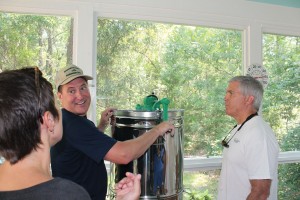





Leave a Reply